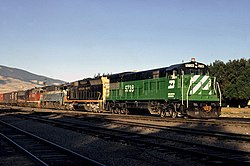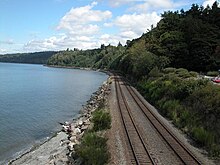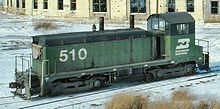Burlington Northern Railroad
 | |
 With three of four predecessor railroad locomotives in a five-unit consist, BN 5738, a GE U33C, departs Livingston, Montana in August 1971. | |
| Overview | |
|---|---|
| Headquarters | Saint Paul, Minnesota (1970–1981) Seattle, Washington (1981–1988) Fort Worth, Texas (1988–1996) |
| Reporting mark | BN |
| Locale | Pacific Northwest, Midwestern United States, Central United States |
| Dates of operation | 1970–1996 |
| Predecessor | Great Northern Railway Northern Pacific Railway Spokane, Portland and Seattle Railway Chicago, Burlington and Quincy Railroad (all merged by March 2, 1970) St. Louis-San Francisco Railway (merged 1980) Colorado and Southern Railway (merged 1981) Fort Worth and Denver Railway (merged 1982) |
| Successor | BNSF Railway |
| Technical | |
| Track gauge | 4 ft 8+1⁄2 in (1,435 mm) standard gauge |
| Length | 27,000 miles (43,000 km) |
The Burlington Northern Railroad (reporting mark BN) was a United States-based railroad company formed from a merger of four major U.S. railroads. Burlington Northern operated between 1970 and 1996.
Its historical lineage begins in the earliest days of railroading with the chartering in 1848 of the Chicago and Aurora Railroad, a direct ancestor line of the Chicago, Burlington and Quincy Railroad, which lends Burlington to the names of various merger-produced successors.
Burlington Northern acquired the Atchison, Topeka and Santa Fe Railway on December 31, 1996, to form the Burlington Northern and Santa Fe Railway (later renamed BNSF Railway), which was owned by the Burlington Northern Santa Fe Corporation. That corporation was purchased by Berkshire Hathaway in 2009[1] which is controlled by investor Warren Buffett.
History
The Burlington Northern Railroad was the product of the merger of four major railroads: the Great Northern Railway, the Northern Pacific Railway, the Spokane, Portland and Seattle Railway and the Chicago, Burlington and Quincy Railroad.
The four railroads shared a very intertwined history, due to the efforts of James J. Hill, the railroad tycoon who had founded the Great Northern Railway. Hill purchased an interest in the Northern Pacific in 1896 as the railway endured a period of financial turmoil. Hill attempted to merge the two railways but was rebuffed by the leaders of the Northern Pacific.
In 1901, the two railways teamed up to purchase nearly all shares of the Chicago, Burlington and Quincy Railroad, giving both a needed connection to Chicago, the nation's railroad hub. That same year, came the next attempt to merge the railroads with the establishment of the Northern Securities Company, a trust that controlled all three, with Hill serving as president. The company was sued in 1902 under the Sherman Antitrust Act and in 1904 the Justice Department won in the Supreme Court ruling Northern Securities Co. v. United States.
Although the ruling forced the three companies to be operated independently, they were still closely linked, even sharing a headquarters building, the Railroad and Bank Building in Saint Paul, Minnesota. In 1905, the Spokane, Portland and Seattle Railway was founded. Like the Chicago, Burlington and Quincy Railroad, this new railroad was co-owned by the Great Northern and Northern Pacific and allowed both to access the Pacific Northwest.
Leaders attempted to merge another two times, in 1927 and 1955, but were unsuccessful.
The four railroads were finally cleared to merge on March 2, 1970, after a legal challenge that once again went to the Supreme Court. A newly established holding company, Burlington Northern, Inc. purchased the four railroad companies and merged them into the Burlington Northern Railroad.
To further expand the Burlington Northern, a single track was constructed in 1972 into the Powder River Basin to serve various coal mines. The expansion was a source of traffic unprecedented in United States railroad history. In 1971, the first full year for the new railroad, trains carried 64,116 million revenue ton-miles of freight, by 1979 the total was 135,004 million.[2] Most of the increase was attributed to Powder River coal from Wyoming.
The Burlington Northern, along with handling freight trains, briefly operated inter-city passenger trains. The BN had started operations just a matter of weeks before the end of service of the original California Zephyr, which had been operated by the CB&Q, in conjunction with the Denver & Rio Grande Western and Western Pacific railroads, and continued to operate the North Coast Limited, Mainstreeter, Empire Builder, Western Star, Denver Zephyr, "Gopher", and "International", until Amtrak took over intercity passenger service in May 1971, thus becoming the last "new" Class I railroad to operate its own passenger trains. The BN also operated a commuter line inherited from the CB&Q from Chicago Union Station to Aurora, Illinois. This line is still owned and operated to this day by the BNSF Railway under a purchase-of-service agreement with Metra.
In May 1980 when Mount St. Helens erupted, the BNR owned the land around the summit of Mount St. Helens in Washington state. In the 19th century, the United States government distributed land to railroads as a way to open up the American West and the 9,677-foot peak was granted to the Northern Pacific. It was inherited in the 1970 merger by Burlington Northern. Following the eruption the land including the volcano was subsequently transferred in a land swap between the railroad and the United States Forest Service so the Mount St. Helens National Volcanic Monument could be established.
On November 21, 1980, the St. Louis–San Francisco Railway was acquired, giving the railroad trackage as far south as Florida.
In the early 1980s two independently operated railroads, owned by Burlington Northern Inc. were absorbed into the Burlington Northern Railroad; the Colorado and Southern Railway was absorbed in 1981, followed by the Fort Worth and Denver Railway in 1982.
The railroad relocated its headquarters from Saint Paul to Seattle, Washington in 1981,[3] as well as its parent company and sister companies.
All of Burlington Northern, Inc's non-rail operations were spun off to a new company, Burlington Resources in 1988.
The railroad once again relocated its headquarters in 1988, moving from Seattle to Fort Worth, Texas.
On September 22, 1995, the Atchison, Topeka and Santa Fe Railway merged with the Burlington Northern to create the Burlington Northern Santa Fe Railway. However, the merger was not official until December 31, 1996, when a common dispatching system was established, Santa Fe's non-union dispatchers were unionized and the implementation of Santa Fe's train identification codes systemwide.[4] On January 24, 2005, the railroad shortened its name to BNSF Railway.[5]
Route


The Burlington Northern traversed the most northerly routes of any railroad in the western United States. These routes started at Chicago, Illinois and ran west-northwest to La Crosse, Wisconsin. From here the routes continued northwest through Minneapolis and St. Paul, Minnesota to Grand Forks, North Dakota. From Grand Forks the routes ran west through North Dakota, Montana, and Idaho to Spokane, Washington. The former GN routed through North Dakota/Northern Montana, crossing the continental divide at Marias Pass, while the former NP line routed through the southern part of Montana (which was spun off to Montana Rail Link in 1987), crossing the continental divide at Mullan and Homestake Passes. At Spokane the routes split into three. The former Great Northern route ran west to Wenatchee, Washington, crossed under the Cascade Range at New Cascade Tunnel on Stevens Pass, and descended to the Puget Sound region through Everett, Washington. The former Northern Pacific turned southwest towards the Tri-Cities, then northwest to Yakima, Washington, and crossed under the Cascade Range at Stampede Tunnel, descending to the Green River Valley at Auburn, Washington where it connected with existing NP lines from British Columbia to Portland, Oregon. The Spokane, Portland and Seattle ran southwest to the Tri-Cities, then followed the north bank of the Columbia River to Vancouver, Washington.

With the acquisition of the St. Louis – San Francisco Railway the route was extended into the South Central and Southeastern United States.
Transport Statistics shows BN operated 23609 miles of line and 34691 miles of track at the end of 1970;[7] it shows 4547 SLSF miles of line not including QA&P and AT&N. At the end of 1981 BN showed 27374 miles of line and 40041 miles of track.[8]
At the time of the 1980 eruption of Mount St. Helens the summit of the volcano that was blasted away was owned by Burlington Northern. Following the eruption, Burlington Northern agreed to a land swap with the U.S. government and exchanged its square mile of land on the mountain for national forest land elsewhere to allow for the creation of the Mount St. Helens National Volcanic Monument to preserve the volcano and allow for its aftermath to be scientifically studied.[9]
Company officers
Presidents of the Burlington Northern Railroad
- Louis W. Menk (1970–1971)[10]
- Robert W. Downing (1971–1976)[11][12]
- Norman Lorentzsen (1976–1981) [13][14]
- Richard C. Grayson (1981–1982)
- Walter A. Drexel (1982–1985)
- Darius W. Gaskins, Jr. (1985–1989)[15][16][17]
- Gerald Grinstein (1989–1995)[18]
- Robert D. Krebs (1995–1996) [Post BN]
See also
References
- ^ Barr, Greg Morcroft, Alistair. "Berkshire Hathaway to buy Burlington Northern Santa Fe". MarketWatch.
{{cite web}}: CS1 maint: multiple names: authors list (link) - ^ Moody's Transportation Manual 1981
- ^ "Taking Control at Burlington". New York Times. April 16, 1982. Retrieved February 15, 2019.
- ^ "Burlington Northern & Santa Fe: Merger". RailNews. Pentrex: 87. March 1997. Archived from the original on October 6, 2013. Retrieved March 24, 2012.
- ^ "Form 10-K: Burlington Northern Santa Fe Corporation for the year ended December 31, 2007". Securities and Exchange Commission. February 15, 2008. Retrieved March 24, 2012.
- ^ "BNSF in Idaho". BNSF Northwest. Retrieved March 12, 2022.
- ^ Not including 692 route-miles operated by C&S, 1201 FW&D, 186 Oregon Electric, 152 Oregon Trunk, 19 Walla Walla Valley and 2 MA&CR.
- ^ Not including 678 route-miles C&S and 1181 miles FW&D.
- ^ "Burlington Northern loses its mountaintop in Mount St. Helens blast on May 18, 1980". historylink.org.
- ^ "nrrhof.org".
- ^ "bnsf.com". Archived from the original on November 21, 2011.
- ^ BN News, May 1971, p. 1
- ^ "Spokane Daily Chronicle". news.google.com – via Google News Archive Search.
- ^ BN News, 1976 Overview pp. 3–5
- ^ "Topic Galleries – Chicago Tribune". chicagotribune.com.
- ^ "Stocks". bloomberg.com.[dead link]
- ^ Kenneth N. Gilpin & Eric Schmitt. "Business People; Burlington Northern Promotes 2 Executives". The New York Times, December 18, 1985.
- ^ Daniel F. Cuff. "Business People; Burlington Northern Names 2 Executives", The New York Times, October 21, 1988.
- Burlington System from the Handbook of Texas Online. Retrieved 2005-05-26.
External links
- Burlington Northern Railroad
- Companies based in Saint Paul, Minnesota
- Defunct Alabama railroads
- Defunct Arkansas railroads
- Defunct California railroads
- Defunct Colorado railroads
- Defunct Florida railroads
- Defunct Idaho railroads
- Defunct Illinois railroads
- Defunct Iowa railroads
- Defunct Kansas railroads
- Defunct Kentucky railroads
- Defunct Minnesota railroads
- Defunct Mississippi railroads
- Defunct Missouri railroads
- Defunct Montana railroads
- Defunct Nebraska railroads
- Defunct New Mexico railroads
- Defunct North Dakota railroads
- Defunct Oklahoma railroads
- Defunct Oregon railroads
- Defunct South Dakota railroads
- Defunct Tennessee railroads
- Defunct Texas railroads
- Defunct Washington (state) railroads
- Defunct Wisconsin railroads
- Defunct Wyoming railroads
- Economy of the Midwestern United States
- Economy of the Northwestern United States
- Former Class I railroads in the United States
- Predecessors of the BNSF Railway
- Railway companies disestablished in 1996
- Railway companies established in 1970
- American companies established in 1970
